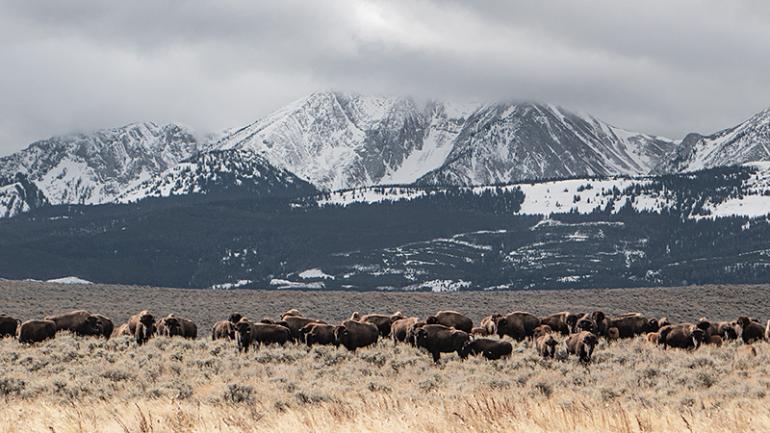Getting Out of a Rut
From veteran environmental advocate to greenhorn bison rancher.
Brow furrowed and jaw set, Matt Skoglund, 41, slams his black F-150 into reverse and digs the tires deeper into the snow. His truck sits high-centered in a snowdrift in the windswept plains spreading east from the Bridger Mountains.
From the back seat, his two kids, Otto, 6, and Gretta, 3, ask if they’re headed to meet their mom.
Matt grumbles a hurried “soon,” stepping out into the snow to survey his predicament. His new herd of nearly 100 bison watches from the other side of the electric fence.
But under the big sky, raising bison is becoming an attractive alternative to raising cattle. Montana ranchers like Skoglund are bucking the status quo and taking a risk on the native animal, although the practice remains a small slice of the industry.
According to the U.S. Department of Agriculture (USDA), there are more than 90 million cattle and fewer than 200,000 privately raised bison in the U.S. The average American eats approximately 55 pounds of beef per year but less than a pound of bison. However, bison sales are growing nationwide, and the value of bison meat has doubled in the last 10 years, according to industry statistics.
This economic trend encouraged Skoglund to leave his career as a lawyer with the Natural Resource Defense Council and jump in feet-first to start North Bridger Bison. He’s selling grass-fed steaks and ground directly to consumers online and maximizing his income by directly targeting a niche market.
But selling the meat is only a fraction of Skoglund’s concerns.
Back in his pasture, he rummages through the bed of his truck for tools to dig himself out of the snow. After some commotion, he emerges with a garden rake and a hay fork. Resigned to the challenge, he stoops his broad shoulders and starts digging.
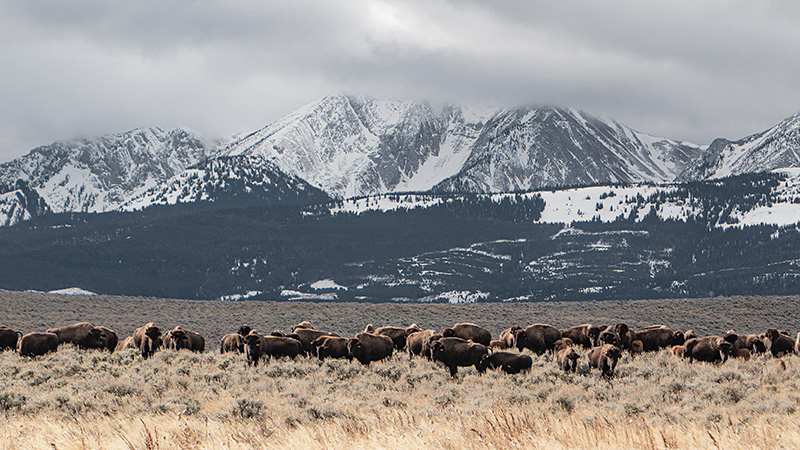
It’s not Skoglund’s first—or last—time getting stuck out on the sagebrush plains of his ranch west of Wilsall. He jokes that he could teach a clinic on the subject. As a first-time rancher, he faces a steep learning curve.
Small ranchers like Skoglund are an emerging demographic in Montana’s bison market, according to the USDA. For years, Montana's bison industry was defined by men like media mogul Ted Turner and late-night entertainer Dave Letterman. Their out of state wealth bought large ranches and large herds.
Turner currently owns more bison than anyone else in the country, and he raises them across his vast real-estate empire of 1.9 million acres. He uses their meat in his restaurants and charges a premium for steaks and bison burgers.
Considering the financial risk of leaving his law career and starting a ranch, Skoglund was thoughtful and contemplative in the process of committing to his new business. With his wife Sarah, they weighed the prospects for their family of four. Ranching would be a significant adjustment, and they would lack the certainty of a steady paycheck.
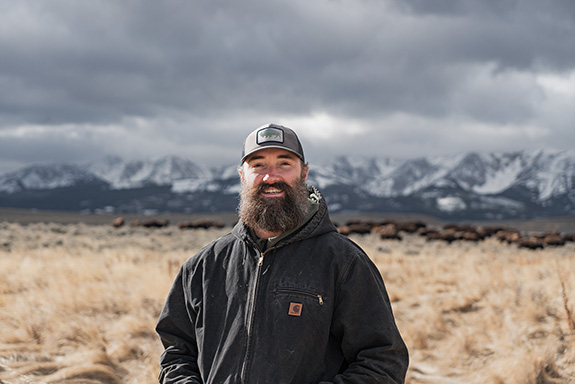
In 2018, they decided to plunge ahead, leaving the nine-to-five and entwining their future with their herd and their land. When their 95 bison arrived in the back of two semitrucks and a horse trailer at the end of January 2019, they were committed.
As a means to diversify their income, they remodeled and old ranch house on the property into a spacious cabin rental. Guests come for the easy recreation access to nearby national forest as well as the opportunity to watch bison out on the landscape.
“We knew that ranching—and starting a ranch from scratch—would not be all pretty sunsets and warm spring days,” says Skoglund. “We knew we would make mistakes. We knew unpredictable stuff would happen.”
The week before Skoglund’s snafu in the snowdrift, he had high-centered his Ford F-350 flatbed on a pile of hay. Quickly, the heat from the engine caused the hay to smolder and smoke. Before he could get the truck free, the hay and his truck went up in flames.
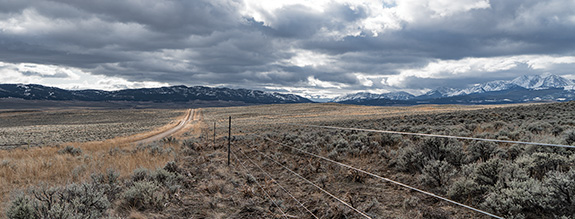
Back in the snowbank, Skoglund grips the rake and gets to work. Sweat drips from under his Backcountry Hunters & Anglers hat as the midday sun turns the snow around his truck to slush and mud.
His muck boots and Carhartt jacket are a big change from the suit and tie he wore for years as a lawyer and environmental advocate. It may seem a dramatic change, but to Skoglund, it’s a continuation of his passion for wildlife and commitment to the environment.
It is estimated that around 30 million bison once roamed North America, but by the turn of the 20th century, fewer than 1,000 bison remained. Today, between public and private herds, bison populations are making a comeback and nearing 500,000. In the 2017 USDA Census, Montana’s ranchers are raising nearly 20,000 bison across the state. It’s a remarkable turnaround, and the success relies heavily on private ranches, where 90% of the animals roam.
Private herds can be found in the Bitterroot Valley, along the Flathead River, just north of the Spanish Peaks, in the sage-covered hills near Wilsall, above the Ruby River, on the expansive ranches of the Rocky Mountain Front, and spread out across the rich prairie of the Missouri Breaks.
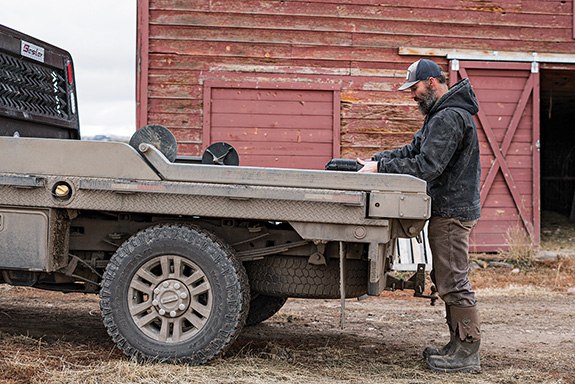
While some bison ranchers use methods that are common in commercial beef, the Skoglunds use ranching techniques that mimic the historic balance of North American’s grasslands and grazers. By frequently moving his herd, Skoglund expects to rebuild his topsoil, increase the productivity of his lands, and provide abundant wildlife habitat on the ranch.
Skoglund uses skills learned from hunting to fill orders for his customers. When he receives an order, he doesn’t send his bison to a feedlot for slaughter. Instead he drives out into the pasture, shoots and field dresses a bison, then takes it to a local butcher for processing. “I’m convinced that the field harvest is part of what makes our meat so delicious,” said Skoglund. “There’s no stress in the meat, and from an ethical and humane standard, it doesn’t get any better.”
But harvesting only happens if he doesn’t get stuck in the mud.
Behind his truck, Skoglund has no choice but to keep digging. He’s committed to his path and is already late to meet his wife in town. His kids grow steadily more impatient. Sweaty and muddy, he finishes clearing the snow around the tires and busts up the largest drifts. He climbs back into the truck, throws it in reverse, and spins out of the snow. As he rumbles toward the highway, his herd of bison stare from the other side of the fence, chew their grass, and mosey on underneath the towering mountains.



